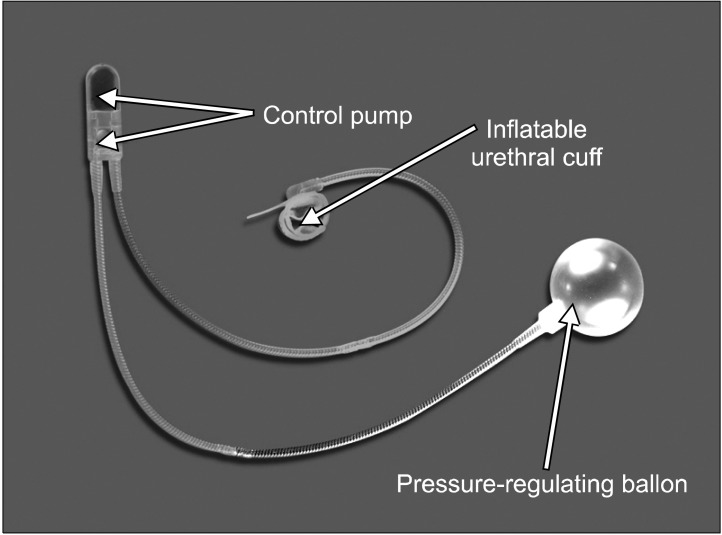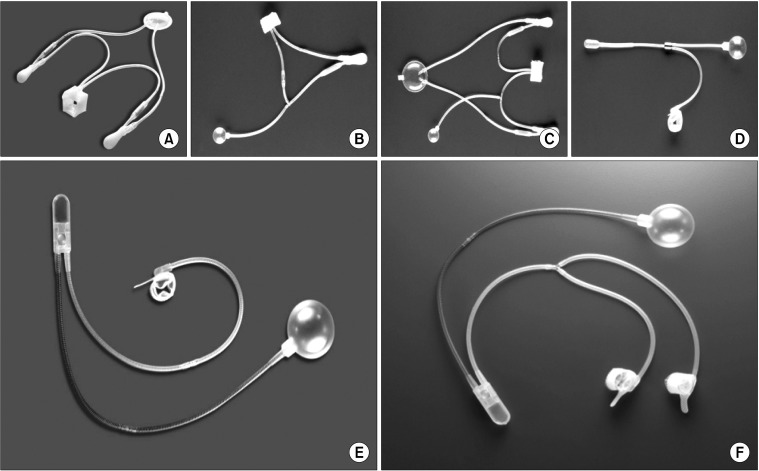World J Mens Health.
2013 Apr;31(1):21-30.
The Current Role of the Artificial Urinary Sphincter in Male and Female Urinary Incontinence
- Affiliations
-
- 1Urology Unit, Department of Surgery, Kulliyyah of Medicine, Jalan Hospital, International Islamic University, Kuantan, Malaysia.
- 2Department of Urology, SMG-SNU Boramae Medical Center, Seoul, Korea. islah75@hotmail.com
Abstract
- The evolution of the artificial urinary sphincter has affected the current surgical options for urinary incontinence. With its unique features, the artificial urinary sphincter (AUS) has been an attractive option for the treatment of urinary incontinence regardless of gender. The current paper discusses the indications, contraindications, types of devices, surgical approaches, outcomes, and complications of the AUS in the treatment of both male and female urinary incontinence. A PubMed review of the available literature was performed and articles reporting implantation of artificial urinary sphincters for urinary incontinence in both male and female patients were evaluated. There was a comparable satisfactory continence rate after the implantation of an AUS (59~97% in males vs. 60~92% in females). In comparison, there were some differences in the indications, contraindications, surgical approaches, outcomes, and complications of the AUS implanted for urinary incontinence in male and female patients. AUS implantation is a safe and effective surgical option for the treatment of urinary incontinence of various etiologies. Continuous evolution of the device has made it an attractive option for the treatment of both male and female urinary incontinence.
Figure
Reference
-
1. Trost L, Elliott DS. Male stress urinary incontinence: a review of surgical treatment options and outcomes. Adv Urol. 2012; 2012:287489. PMID: 22649446.
Article2. Petero VG Jr, Diokno AC. Comparison of the long-term outcomes between incontinent men and women treated with artificial urinary sphincter. J Urol. 2006; 175:605–609. PMID: 16407005.
Article3. Sandhu JS, Maschino AC, Vickers AJ. The surgical learning curve for artificial urinary sphincter procedures compared to typical surgeon experience. Eur Urol. 2011; 60:1285–1290. PMID: 21665357.
Article5. Herschorn S, Bruschini H, Comiter C, Grise P, Hanus T, Kirschner-Hermanns R, et al. Committee of the International Consultation on Incontinence. Surgical treatment of stress incontinence in men. Neurourol Urodyn. 2010; 29:179–190. PMID: 20025026.
Article6. Ratan HL, Summerton DJ, Wilson SK, Terry TR. Development and current status of the AMS 800 artificial urinary sphincter. EAU-EBU Update Ser. 2006; 4:117–128.
Article7. Buckley BS, Lapitan MC. Epidemiology Committee of the Fourth International Consultation on Incontinence, Paris, 2008. Prevalence of urinary incontinence in men, women, and children--current evidence: findings of the Fourth International Consultation on Incontinence. Urology. 2010; 76:265–270. PMID: 20541241.
Article8. Khoury S, Cockett A, Aso Y, Chatelain C, Andersson L, Abrams P, et al. International Consultation on Urological Diseases: a decade of progress. Prostate. 2000; 45:194–199. PMID: 11027419.
Article9. Cho MC, Park JH, Jeong MS, Yi JS, Ku JH, Oh SJ, et al. Predictor of de novo urinary incontinence following holmium laser enucleation of the prostate. Neurourol Urodyn. 2011; 30:1343–1349. PMID: 21538499.
Article10. AUA Practice Guidelines Committee. AUA guideline on management of benign prostatic hyperplasia (2003). Chapter 1: Diagnosis and treatment recommendations. J Urol. 2003; 170:530–547. PMID: 12853821.11. Son H, Song SH, Paick JS. Current laser treatments for benign prostatic hyperplasia. Korean J Urol. 2010; 51:737–744. PMID: 21165192.
Article12. Te AE, Malloy TR, Stein BS, Ulchaker JC, Nseyo UO, Hai MA, et al. Photoselective vaporization of the prostate for the treatment of benign prostatic hyperplasia: 12-month results from the first United States multicenter prospective trial. J Urol. 2004; 172:1404–1408. PMID: 15371855.
Article13. Spaliviero M, Araki M, Culkin DJ, Wong C. Incidence, management, and prevention of perioperative complications of GreenLight HPS laser photoselective vaporization prostatectomy: experience in the first 70 patients. J Endourol. 2009; 23:495–502. PMID: 19265468.14. Park JH, Son H, Paick JS. Comparative analysis of the efficacy and safety of photoselective vaporization of the prostate for treatment of benign prostatic hyperplasia according to prostate size. Korean J Urol. 2010; 51:115–121. PMID: 20414424.
Article15. Elzayat EA, Habib EI, Elhilali MM. Holmium laser enucleation of the prostate: a size-independent new "gold standard". Urology. 2005; 66(5 Suppl):108–113. PMID: 16194716.
Article16. Elzayat EA, Elhilali MM. Holmium laser enucleation of the prostate (HoLEP): the endourologic alternative to open prostatectomy. Eur Urol. 2006; 49:87–91. PMID: 16314033.
Article17. Vavassori I, Hurle R, Vismara A, Manzetti A, Valenti S. Holmium laser enucleation of the prostate combined with mechanical morcellation: two years of experience with 196 patients. J Endourol. 2004; 18:109–112. PMID: 15006063.
Article18. Thomas K, Venn SN, Mundy AR. Outcome of the artificial urinary sphincter in female patients. J Urol. 2002; 167:1720–1722. PMID: 11912395.
Article19. Venn SN, Greenwell TJ, Mundy AR. The long-term outcome of artificial urinary sphincters. J Urol. 2000; 164:702–706. PMID: 10953129.
Article20. Costa P, Poinas G, Ben Naoum K, Bouzoubaa K, Wagner L, Soustelle L, et al. Long-term results of artificial urinary sphincter for women with type III stress urinary incontinence. Eur Urol. 2013; 63:753–758. PMID: 22445222.
Article21. Donovan MG, Barrett DM, Furlow WL. Use of the artificial urinary sphincter in the management of severe incontinence in females. Surg Gynecol Obstet. 1985; 161:17–20. PMID: 4012538.22. O'Connor RC, Kuznetsov DD, Patel RV, Galocy RM, Steinberg GD, Bales GT. Artificial urinary sphincter placement in men after cystectomy with orthotopic ileal neobladder: continence, complications, and quality of life. Urology. 2002; 59:542–545. PMID: 11927310.23. Smith JJ, Barrett DM. Glenn JF, Keane TE, Brendler CB, Gormley EA, Jordan GH, Kavoussi LR, editors. Artificial urinary sphincter for incontinence. Glenn's urologic surgery. 2004. 6th ed. Philadelphia: Williams & Wilkins;p. 414–421.24. Wessells H, Peterson AC. Kavoussi LR, Novick AC, Partin AW, Peters CA, editors. Surgical procedures for sphincteric incontinence in the male: the artificial genitourinary sphincter and perineal sling procedures. Campbell's urology. 2012. 10th ed. Philadelphia: Saunders;p. 2290–2305.25. Dorsher PT, McIntosh PM. Neurogenic bladder. Adv Urol. 2012; 2012:816274. PMID: 22400020.
Article26. Elliott DS, Barrett DM. The artificial urinary sphincter in the female: indications for use, surgical approach and results. Int Urogynecol J Pelvic Floor Dysfunct. 1998; 9:409–415. PMID: 9891964.
Article27. Schiavini JL, Damião R, de Resende Júnior JA, Dornas MC, Cruz Lima da Costa DS, Barros CB. Treatment of post-prostate surgery urinary incontinence with the periurethral constrictor: a retrospective analysis. Urology. 2010; 75:1488–1492. PMID: 20399484.
Article28. Leibovich BC, Barrett DM. Use of the artificial urinary sphincter in men and women. World J Urol. 1997; 15:316–319. PMID: 9372584.
Article29. Vayleux B, Rigaud J, Luyckx F, Karam G, Glémain P, Bouchot O, et al. Female urinary incontinence and artificial urinary sphincter: study of efficacy and risk factors for failure and complications. Eur Urol. 2011; 59:1048–1053. PMID: 21420781.
Article30. Walsh IK, Williams SG, Mahendra V, Nambirajan T, Stone AR. Artificial urinary sphincter implantation in the irradiated patient: safety, efficacy and satisfaction. BJU Int. 2002; 89:364–368. PMID: 11872025.
Article31. Kim SP, Sarmast Z, Daignault S, Faerber GJ, McGuire EJ, Latini JM. Long-term durability and functional outcomes among patients with artificial urinary sphincters: a 10-year retrospective review from the University of Michigan. J Urol. 2008; 179:1912–1916. PMID: 18353376.
Article32. Gomha MA, Boone TB. Artificial urinary sphincter for post-prostatectomy incontinence in men who had prior radiotherapy: a risk and outcome analysis. J Urol. 2002; 167:591–596. PMID: 11792924.
Article33. Vakalopoulos I, Kampantais S, Laskaridis L, Chachopoulos V, Koptsis M, Toutziaris C. New artificial urinary sphincter devices in the treatment of male iatrogenic incontinence. Adv Urol. 2012; 2012:439372. PMID: 22567002.
Article34. Gamé X, Bram R, Abu Anz S, Doumerc N, Guillotreau J, Malavaud B, et al. Laparoscopic insertion of artificial periprostatic urinary sphincter. Urology. 2009; 73:442.e1–442.e3. PMID: 18533234.
Article35. Rouprêt M, Misraï V, Vaessen C, Cardot V, Cour F, Richard F, et al. Laparoscopic approach for artificial urinary sphincter implantation in women with intrinsic sphincter deficiency incontinence: a single-centre preliminary experience. Eur Urol. 2010; 57:499–504. PMID: 19346059.
Article36. Mandron E, Bryckaert PE, Papatsoris AG. Laparoscopic artificial urinary sphincter implantation for female genuine stress urinary incontinence: technique and 4-year experience in 25 patients. BJU Int. 2010; 106:1194–1198. PMID: 20132197.
Article37. Ngninkeu BN, van Heugen G, di Gregorio M, Debie B, Evans A. Laparoscopic artificial urinary sphincter in women for type III incontinence: preliminary results. Eur Urol. 2005; 47:793–797. PMID: 15925075.
Article38. Wilson S, Delk J 2nd, Henry GD, Siegel AL. New surgical technique for sphincter urinary control system using upper transverse scrotal incision. J Urol. 2003; 169:261–264. PMID: 12478150.
Article39. Henry GD, Graham SM, Cornell RJ, Cleves MA, Simmons CJ, Vakalopoulos I, et al. A multicenter study on the perineal versus penoscrotal approach for implantation of an artificial urinary sphincter: cuff size and control of male stress urinary incontinence. J Urol. 2009; 182:2404–2409. PMID: 19762042.
Article40. Appell RA. Techniques and results in the implantation of the artificial urinary sphincter in women with type III stress urinary incontinence by a vaginal approach. Neurourol Urodyn. 1988; 7:613–619.
Article41. Hajivassiliou CA. A review of the complications and results of implantation of the AMS artificial urinary sphincter. Eur Urol. 1999; 35:36–44. PMID: 9933793.
Article42. Singh G, Thomas DG. Artificial urinary sphincter for post-prostatectomy incontinence. Br J Urol. 1996; 77:248–251. PMID: 8800893.
Article43. O'Connor RC, Lyon MB, Guralnick ML, Bales GT. Long-term follow-up of single versus double cuff artificial urinary sphincter insertion for the treatment of severe postprostatectomy stress urinary incontinence. Urology. 2008; 71:90–93. PMID: 18242372.44. Gousse AE, Madjar S, Lambert MM, Fishman IJ. Artificial urinary sphincter for post-radical prostatectomy urinary incontinence: long-term subjective results. J Urol. 2001; 166:1755–1758. PMID: 11586217.
Article45. Elliott DS, Barrett DM. Mayo Clinic long-term analysis of the functional durability of the AMS 800 artificial urinary sphincter: a review of 323 cases. J Urol. 1998; 159:1206–1208. PMID: 9507835.
Article46. Hussain M, Greenwell TJ, Venn SN, Mundy AR. The current role of the artificial urinary sphincter for the treatment of urinary incontinence. J Urol. 2005; 174:418–424. PMID: 16006857.
Article47. Webster GD, Sherman ND. Management of male incontinence following artificial urinary sphincter failure. Curr Opin Urol. 2005; 15:386–390. PMID: 16205488.
Article48. Costa P, Mottet N, Rabut B, Thuret R, Ben Naoum K, Wagner L. The use of an artificial urinary sphincter in women with type III incontinence and a negative Marshall test. J Urol. 2001; 165:1172–1176. PMID: 11257664.
Article49. Barrett DM, Furlow WL. Radical prostatectomy incontinence and the AS791 artificial urinary sphincter. J Urol. 1983; 129:528–530. PMID: 6834538.
Article50. Brito CG, Mulcahy JJ, Mitchell ME, Adams MC. Use of a double cuff AMS800 urinary sphincter for severe stress incontinence. J Urol. 1993; 149:283–285. PMID: 8426402.
Article51. Litwiller SE, Kim KB, Fone PD, White RW, Stone AR. Post-prostatectomy incontinence and the artificial urinary sphincter: a long-term study of patient satisfaction and criteria for success. J Urol. 1996; 156:1975–1980. PMID: 8911369.
Article52. Light JK, Scott FB. Management of urinary incontinence in women with the artificial urinary sphincter. J Urol. 1985; 134:476–478. PMID: 4032543.
Article
- Full Text Links
- Actions
-
Cited
- CITED
-
- Close
- Share
- Similar articles
-
- A Case of Urinary Incontinence Treated with AMS 800 Artificial Sphincter
- A Case of Urinary Incontinence Treatment Using AMS 800-Artificial Sphincter
- The artificial urinary sphincter and male sling for postprostatectomy incontinence: Which patient should get which procedure?
- Artificial Urinary Sphincter for Postradical Prostatectomy Urinary Incontinence — Is It the Best Option?
- Sling Surgery for Male Urinary Incontinence Including Post Prostatectomy Incontinence: A Challenge to the Urologist



